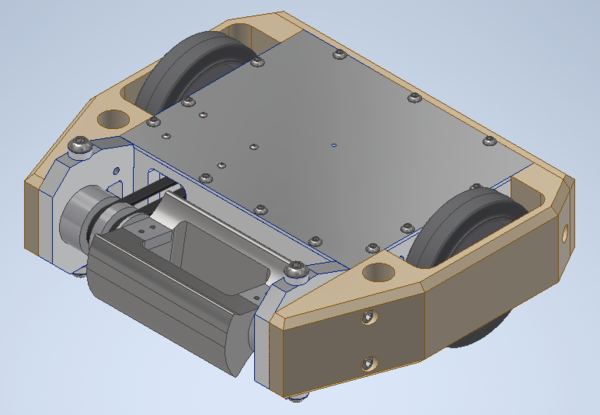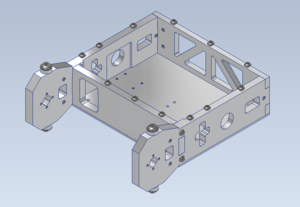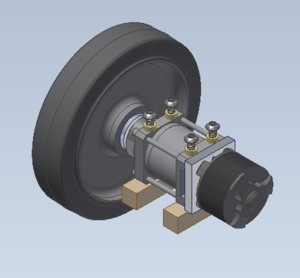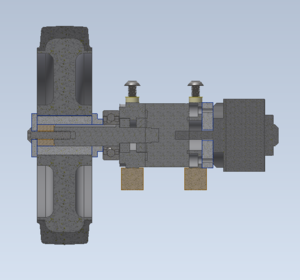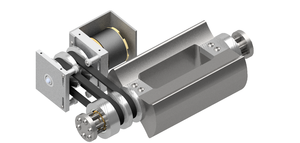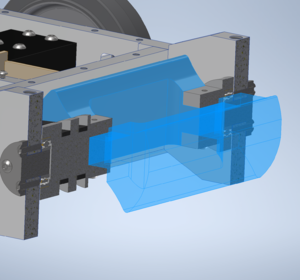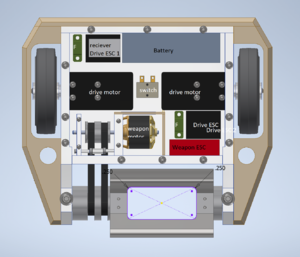Difference between revisions of "Maori Design Guide"
(→Overview) |
(→Overview) |
||
| Line 8: | Line 8: | ||
==== Overview ==== | ==== Overview ==== | ||
| − | [[File:.png|right|thumb|300px| | + | [[File:Chassis.png|right|thumb|300px|Chassis Assembly]] |
Maori's chassis consists of six parts: A top, bottom, front, and back plate as well as two side plates. All of these components are made from 6061 Aluminum. | Maori's chassis consists of six parts: A top, bottom, front, and back plate as well as two side plates. All of these components are made from 6061 Aluminum. | ||
The side plates provide thicker support towards the weapon, while allowing skids to be inserted. Maori's drive modules also fit into the side plates. | The side plates provide thicker support towards the weapon, while allowing skids to be inserted. Maori's drive modules also fit into the side plates. | ||
Revision as of 18:39, 11 April 2020
Contents
Introduction
test
Design Basics
Chassis
Overview
Maori's chassis consists of six parts: A top, bottom, front, and back plate as well as two side plates. All of these components are made from 6061 Aluminum. The side plates provide thicker support towards the weapon, while allowing skids to be inserted. Maori's drive modules also fit into the side plates. The front plate allows for belt access between the interior of the robot and the weapon pulley. It also fits into the side plates The bottom and top plates provide slots for interior plastic guards and bolt into the rest of the chassis.
Design Decisions
Overall, the chassis of our drum type spinner robots have always focused on durability and survivability. We use thicker aluminum plates that slot into each other, along with steel bolts to ensure the base structure of our robot is strong. No real surprises here.
Side Plates (0.5"): Slightly thicker towards the front, along with a slightly flared and rounded profile. Drum spinners run the risk of being ripped open by other robots if the interface between the weapon and chassis is not well put together. To account for this, the front of Maori is a bit thicker than the rest of the side plate (0.625" vs 0.5"). The roundedness to the head/lack of corners is to reduce the number of places where a horizontal spinner would be able to get a good hit on that support portion of the side plates. Cut-outs on the side plates allow for access to the tensioning system for the belt once the armor is removed. The side plates also have weight saving cut outs, and slight pockets that let the drive modules slot in nicely.
Front Plate (0.5"): Standard plate with a cut-out for the belt. Pocketing here gives a bit more room for electronics, while still providing structural support. Slots into side plates.
Back Plate (0.375"): Slightly thinner than the rest of the main chassis plates, but has general weight saving cut-outs. The general idea is that this plate will be slightly thinner as it should not be hit extensively during a fight. Armor also helps with this.
Top/Bottom Plate (0.125"): Maybe slightly too thin, but seemed to hold up well during assembly and testing. Provides holes that allow the tensioning system to bolt into something, while also providing some slots for internal plastic guards.
- Notes/Helpful Advice
- test
Armor
Overview
Maori's armor is composed of three HDPE components. This consists of two side armor blocks and a plate mounted to the back.
Design Decisions
The design behind the armor was striving to make the robot profile a bit rounded. The armor is fairly thick (0.5"-2.25") HDPE. The armor in this case wraps around the wheels. This is over the choice to have another side plate what would protect the wheels. The success of this choice hasn't been tested yet, but at least we believed that the thinner section of the HDPE around the wheels would be able to protect them. Apart from the weight saving cuts, this armor acts as our usual thick HDPE armor does.
- Notes/Helpful Advice
- test
Drive
Overview
The drive assembly is a robust one: An outrunner motor adapted to fit into a Bane Bots gearbox. A multi-piece hub and spacer set, along with a bearing pressed into the side plate allow for proper function.
Design Decisions
Wheels: Performa Wheels (5") are always a good pick due to their solid build and great traction. The hubs that came with the wheels were pressed out for our own custom hubs.
Wheel Hubs: Made of aluminum, these hubs key into the wheel. The hub then keys into the shaft of the gearbox, allowing for rotational transmission. In terms of transverse constraints, the inner bore of the gearbox shaft is threaded. Because of this, we were able to make the head of the hub a separate piece that bolts on to keep the wheel in place against a tiered spacer.
Gearbox: Its specifications can be found in the electronics section. In terms of mechanics, the specific gearbox back plate topology was chosen to allow the motor to bolt on. The gearbox also has bolt holes that allow it to be mounted to the bottom plate, and allow the 3D-printed cover to be mounted. A bank pinion gear was ordered and machined in order to properly interface the added motor and gearbox on the inside.
Motor: Its specifications can be found in the electronics section.
3D-printed Cover: A simple enclosure that houses the drive system. Allowed for wires to be routed over and around the drive system.
Calculations
test
- Notes/Helpful Advice
- test
Weapon
Overview
Maori's weapon system consists of a steel drum to cause damage to opponents and two aluminum hubs to interface the weapon with the chassis. The drum is constrained to the hubs with bolts perpendicular to the axis of rotation to minimize loosening caused by vibration. The fork shape of the hubs compromises ease of machining with functionality.
Design Decisions
The material used for the beater bar was S7 Tool Steel. In practice, this material is a good fit for the weapon. While designing the beater bar, compatibility with EDM (electron-discharge machining) was prioritized. The beater bar was given a constant cross-section along the axis of rotation to help in this regard. The profile of the beater bar is rotationally symmetric for 180 degrees to minimize vibration induced by an offset center of mass. Flats on each teeth were part of this profile to use for clamping when milling out the interior profile. The teeth of this profile were a significant issue during testing, as they reduced the "reach" of the weapon - the teeth were the same radius as the majority of the weapon, allowing objects to just bounce off of the weapon instead of getting damaged.
The hubs used to constrain the beater bar were made of Aluminum 6061-T6. These parts were machined in house, so ease of machining outweighed high-strength material selection. However, the brunt of forces are received by the beater bar and chassis, meaning high-strength material was not necessary, and in fact benefits the design. This material selection allows deformation of the hubs before the beater bar and chassis (which were more complex parts and thus harder to machine). The hubs interface with the beater bar using a fork-shaped puzzle fit, which constrains axial and radial motion. A dual belt slot was machined into one of the hubs to interface with the weapon motor. Using two belts effectively halves the load on the belts and allows a "built-in" backup belt in the event one is torn by an opponent. The hubs, similarly to the the beater bar, are rotationally symmetric for 180 degrees to avoid skewing the center of mass of the weapon assembly.
The section view of the weapon assembly shows how steel "pins" were bolted into the side plates of the chassis, allowing the bearings which were press-fit into the hubs to have a dead shaft to sit on.
Calculations
test
- Notes/Helpful Advice
- test
Electronics
Overview
Maori uses a single battery that powers three parallel circuits, two of which are for drive. There are two 100 A fuses: one for the weapon, the other in series with the two drive circuits.
Here is a list of components:
- Turnigy 5000 mAh 6S 25C Lipo pack
- FrSky X8R 8-channel 2.4ghz reciever
- 2 Racerstar 120A ESC rated for 2-6S (drive ESCs)
- Scorpion Tribunis 06-120A SBEC (weapon ESC)
- 2 Propdrive v2 4238 750KV brushless outrunner motor rated for 80A and 2-4S
- Scorpion SII-4025-440KV
- 2 Blue Sea AMI/MIDI 100A fuses
- Team Whyachi MS-05 Switch
Drive
The drive motors we went with were chosen for their theoretical performance discussed in the calculations portion of the Drive section. An interesting addition is that these motors were used in crippling depression, a very useful bot for learning about the 30lb weight class created by Robert Cowan.
Weapon
test
- Notes/Helpful Advice
- Racerstar is sold by Banggood. This seller took 6 months for us to finally receive our ESCs.
- The racerstar ESCS, as far as we could find, are not programmable, so we could not adjust the specifics of how they work.
- The Scorpion ESC requires a lot of reprogramming. There is a software available on the scorpion website under the same page the esc was purchased. We were unable to finish getting the ESC to work optimally due to covid-19. Out of the box, the motor and ESC have a spin-up of about 15-20 seconds which is unacceptable.
